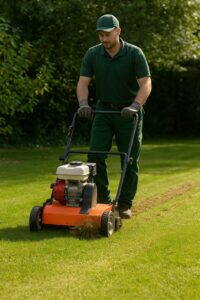Why Lawn Thatch is a Hidden Problem
When most people think about why their lawn isn’t thriving, they imagine issues like moss, weeds, grubs, disease or lack of nutrients. But often, the real culprit is something you can’t see at first glance: lawn thatch.
Thatch is the dense, fibrous layer made up of dead moss, roots, and grass stems that builds up between the green shoots of your lawn and the soil beneath. A little bit of thatch can be beneficial — it cushions the soil, reduces wear, helps to withold moisture in the soil during drought, and protects grass roots. But when it grows too thick, thatch becomes a silent suffocator.
 Why Too Much Thatch is a Problem
Why Too Much Thatch is a Problem
A thin layer of thatch (around half a centimetre) is normal and healthy. But when it exceeds this, problems quickly begin:
- Blocks water and fertiliser: Instead of soaking into the soil, vital nutrients sit on top of the thatch layer, leaving grass roots starved. Moisture is soaked up in the thatch like a sponge and doesn’t make it down to the soil.
- Encourages moss and weeds: Moss, in particular, loves the damp, compact conditions that heavy thatch creates.
- Soft, spongy lawns: Thatch acts like a sponge, holding water at the surface, making turf bouncy and difficult to mow. Spores of fungal diseases like red-thread or fusarium patch can lay dormant in thatch and when the conditions are right for the disease to break out thachy lawns are more vulnerable to fungal disease.
Over time, the grass becomes weak, thin, and patchy, while moss and weeds take over.
The Science & Art of Scarification
At Shrekfeet Independent Lawncare, we approach thatch removal as both a science and an art. The professional term for this process is scarification — using specialist machinery to cut into the turf and power-rake the surface to pull out layers of thatch.
Done correctly, scarification removes excessive thatch without harming the healthy grass you want to keep. However, the process is more complex than simply raking. Timing, depth, and follow-up care are critical.
Yes, lawns often look rough or “battered” immediately after scarification. But this is temporary. With the right aftercare, the transformation is dramatic:
✔ Thicker, lusher grass growth
✔ Improved drainage and root development
✔ Reduced risk of lawn disease
✔ Stronger grass that resists moss and weeds
Why Aftercare Matters
Scarification is just the beginning. To achieve long-lasting results, it should ideally be paired with a structured aftercare programme. At Shrekfeet Independent Lawncare we often combine scarification with:
- Overseeding: Fresh seed fills the gaps, thickening the sward and preventing moss from reclaiming bare patches.
- Targeted feeding: Nutrients support recovery and promote stronger, greener growth.
- Aeration (if needed): Relieving compaction and improving drainage to developer greater root mass, depth and health.
This holistic approach ensures that lawns recover quickly and emerge healthier, greener, and more resilient than before.
Is Your Lawn at Risk?
If your lawn feels spongy, looks patchy, or suffers from persistent moss, thatch could be the problem. The good news is that it’s fixable — and with professional care, the results are both immediate and long-lasting.
Book Your Lawn Survey Today
Don’t let hidden thatch suffocate your lawn. With professional scarification and a tailored aftercare plan, Shrekfeet will restore your lawn’s health and beauty.
👉 Book your free lawn survey
👉 Enquire today for scarification treatments
You deserve a lawn to be proud of, all year round.

 Established 2016
Established 2016



